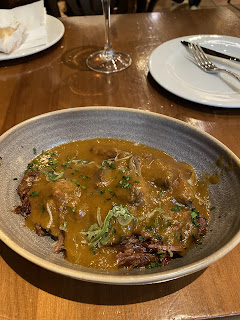I realized it was a bit misleading when I said that the artist, who was born in Malaga, was a well known 19th Century artist. He was born in the 19th Century, but didn’t become famous until the early 20th Century. Here is the picture he collaborated with his nephew. Did you guess who it was?
Picasso.
I’ll be honest, I never understood how cubism was considered serious art. For me, it’s kind of like rap music. I appreciate the form, but don’t understand how it’s taken seriously. There are however, a couple of pieces of Picasso’s that I’ve liked. I enjoy his dove series of paintings/sketches, as well as some of his bull and chicken drawings.
This morning’s breakfast was a suggested place by my AirBnB host. It was at a place called, Tejeringos, which is actually another word for churro. I think every culture has some form of fried dough. The churros here are piped into an overlapping circle without the characteristic ridges we’re more familiar with. They are also not sprinkled with cinnamon sugar, but rather are used for dipping into a chocolate sauce. I chose a praline chocolate for mine. I also took a couple of pictures as the chef created them.
I also ordered bread with sobrasada. I thought this was a sliced cured type of meat. What came out on my bread looked more like a thick tomato paste. But the weird this is, it didn’t taste like tomato. It was very delicious, but I couldn’t figure out what the flavor was. It tasted meaty, sort of, with garlic and paprika flavors…I confused me a lot. Later, I looked up the word and found a recipe that is chorizo with lots of other things, including garlic and paprika with cheese, almonds and oil - processed all together until you get a smooth paste. I definitely need to try this one.
By the time I left, there was a line out the door waiting for their churros.
I then walked to the Alcazaba. Similar to the Alhambra in Granada, the Alcazabar was built three - four hundred years before in the early 11th Century. It is a double walled fortress that overlooks Malaga with towers and a palace. The Castle of Gilbralfaro sits even higher on the hill and was built as an expansion over top of a Phoenician fortification that was there in 770 BCE. The entire complex overlooks the Roman forum that was built at the bottom of the hill in the 1st Century. Because this complex is much earlier than the Alhambra in Granada, it is more simplistic, but you can definitely see a resemblance. The Alcazaba wanders more as it fits into the terrain of the hillside. My favorite part is the drainage/irrigation system. At the top of the Alcazaba there is a big “pool” or what we’d call a cistern which drains the water from the bottom into a planned system that fills shallow pools and fountains at lower elevations. It branches off and runs down next to pathways and steps. There is a longer path that leads along the wall to the Castle, but I chose not to walk up this section. I’ll just leave a bunch of pictures here. First of the Roman Forum and then of the Alcazaba. Enjoy.
And for dinner; first course Smoked Salmon on Focaccia bread with avocado, caramelized onions and hollandaise sauce. Interesting combo. Second course, more oxtail stew - I think this might be my third time ordering it at different places. And a glass of local wine.
Ok, I confess. I ate the chips, too. But, I did not have another dessert! Tomorrow I’m off to Ronda, a small cliff side town that has seen many centuries of various conquerors going all the way back to the Celts who established a city here called Arunda in the 6th Century BCE.
















































No comments:
Post a Comment